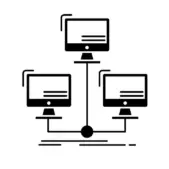As businesses across industries accelerate their digital transformation efforts, they often face various complex challenges that can hinder their success. The path to a thriving digital business is fraught with obstacles, such as siloed teams, outdated processes, change resistance, and a lack of digital dexterity. We explore how strategic UI/UX design can help you overcome these barriers.
Whether you’re a business leader, UX designer, or digital transformation specialist, this guide will provide practical, user-centric strategies. Let’s conquer the digital challenges that stand in the way of your organization’s success.
1. Leadership and Vision
Without strong leadership and a clear vision, digital projects can easily get bogged down in bureaucracy and internal politics. Several everyday leadership and vision challenges can hinder digital transformation efforts. For instance:
- Lack of executive sponsorship and alignment around a shared vision for the initiative
- Indecisive or “committee-style” decision-making without clear direction and urgency
- Leaders bring their ideas without a willingness to test hypotheses through research.
- Closed-mindedness and resistance to new ideas, especially from certain team members
- Misaligned objectives and incentives across different departments and levels of leadership

The UI/UX design process can be beneficial in quickly solving these challenges. It facilitates workshops and exercises aligning leadership with a clear, user-centric vision. The method also involves user research to uncover UX insights and opportunities that transcend internal politics.
What’s more, design sprints and iterative testing promote cross-functional collaboration and allow UX optimization based on user feedback and hard data. The UI/UX design process is key to helping leaders translate complex business goals and requirements into intuitive, personalized digital experiences.
2. Silos
Departmental silos can create a range of business challenges, such as:
- Duplicative work and misalignment across teams
- Loss of company vision and communication problems
- Negative customer experiences due to fragmented processes
- Inconsistent marketing and branding across channels
- Lack of familiarity between employees across departments
These issues can collectively lead to a substantial loss of revenue for the organization. But UI/UX design strategies can help break down these silos by bridging gaps between departments. Intuitive user interfaces enable significantly better cross-team collaboration and communication. What’s more, through seamless, cross-functional workflows and information flows, you can create a cohesive, consistent brand experience across all customer touchpoints.
With the data gathered across different departments, you also gain valuable customer insights to inform a unified, customer-centric approach across the business. When strategically implemented, these insights can offer you a key competitive advantage.
In short, user-centered design helps you break down silos to deliver a more streamlined, efficient, and differentiated digital experience.
3. People
The “people” factor can be a noteworthy challenge in digital transformation—specifically, the digital dexterity of individuals across the organization. Digital dexterity encompasses beliefs, mindsets, and behaviors that enable individuals to build and run digital businesses successfully.
Gartner identifies the key areas of digital dexterity: people need the ambition and ability to work digitally and the ambition and ability to build a digital business. The most impactful individuals score highly across all areas. As you assess your team, evaluate the following five key competencies that drive digital dexterity:
- Business acumen
- Adaptability
- Political savvy
- Fusion collaboration
- Systems thinking
UI/UX design can help your team develop digital dexterity. Specifically, it:
- Creates intuitive, user-friendly tools and workflows that empower employees to work more efficiently and collaboratively
- Gathers employee insights to understand skill gaps and needs
- Designs training and support programs that build critical digital capabilities
- Fosters a culture of innovation, adaptability, and customer-centricity through the design of digital experiences

When you address people’s challenges through a user-centric lens, you can build a digitally dexterous workforce capable of successfully driving sustainable digital transformation.
4. Processes
Good processes can save time, increase efficiency, and enable quicker, smarter decision-making. But the real challenge arises when these processes are fragmented across the organization. For instance, one team may use agile methodologies, while another is still mired in outdated, slow-moving approaches. Or, the UX team may embrace design thinking while the development team lags behind. This lack of alignment and consistency across processes can create significant friction and bottlenecks.
Process challenges have a number of key symptoms, such as:
- Constant conflicts and miscommunication between teams
- Lack of empowerment and accountability for digital project managers
- Delays in getting answers, resources, and decisions
- Frequent rescheduling of meetings and lack of documented requirements
To address these challenges through UI/UX design,
- Design seamless, cross-functional workflows and collaboration tools.
- Facilitate the adoption of user-centric methodologies like design thinking.
- Develop performance dashboards and metrics to align and track progress.
- Enhance communication, transparency, and accountability across teams
5. Culture
The significant cultural challenge for digital businesses is the tension between being operationally minded versus innovation minded. Companies focusing on operations prioritize efficiency and productivity, while innovation-focused companies seek new opportunities and disruptive change. This conflict can hamper digital transformation efforts.
UI/UX design can help bridge this gap. It focuses on user-centered design to identify customer needs and pain points that digital solutions can address. When you emphasize the importance of testing and iterating on digital solutions, teams can reach a balance between function and innovation. That is, rather than just throwing ideas out there.
The UI/UX design process also facilitates collaboration between cross-functional teams, such as IT and business, to break down silos and develop empathy for different perspectives. What’s more, it allows external digital partners to take the lead and push the organization to improve its digital capabilities.
Conquer Your Digital Obstacles With UpTop’s Expertise
The digital landscape is constantly evolving, but the organizations that can adapt and overcome the complex challenges that stand in their way will thrive. Align your leadership, break down silos, empower people, optimize your processes, and cultivate the right culture. As a result, you’ll deliver exceptional customer experiences that drive your digital transformation forward.
If your business is struggling to navigate these barriers, let’s chat. The experts at UpTop are ready to help and explore customized solutions to guide you to digital success.



